 | ||
Copper hydride is a pyrophoric, inorganic compound with the chemical formula (CuH)
n (also written as [CuH]
n or CuH). It is an odourless, metastable, red solid, rarely isolated as a pure composition, that decomposes to the elements. Copper hydride is mainly produced as a reducing agent in organic synthesis and as a precursor to extremely reactive catalysts.
Contents
- Nomenclature
- History
- Structure
- Chemical reactions
- Production
- Reductive sonication
- Molecular form
- Chemical properties
- Anhydrous reduction
- Direct synthesis
- Applications in Organic Synthesis
- Other copper hydrides
- References

Nomenclature
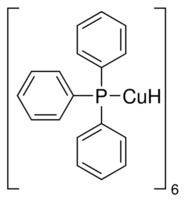
The systematic name copper hydride is the most commonly used name. It is a valid IUPAC name, being constructed according to compositional nomenclature.
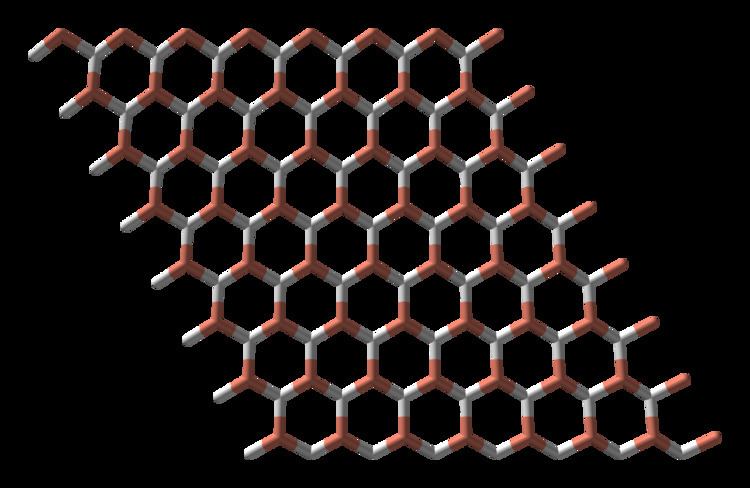
Copper hydride is also used generically to refer to the alloyed mixture of copper and atomic hydrogen, known as the copper-hydrogen system, of which there exists various phases. It is also used to refer to any compound containing a Cu-H bond. The oxidation state of copper in copper hydride is +1.
History
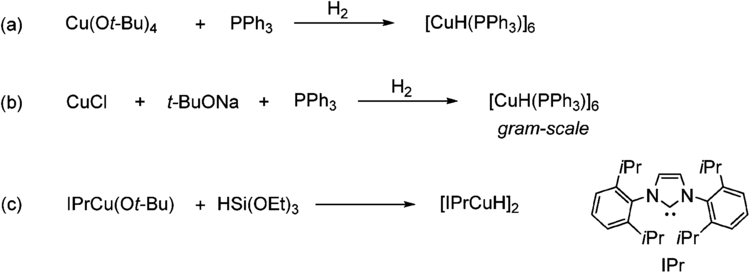
In 1844, the French chemist Adolphe Wurtz synthesised copper hydride for the first time. This reaction consisted of the reduction of copper sulfate with hypophosphorous acid. In 2011, Panitat Hasin and Yiying Wu were the first to synthesise a metal hydride (copper hydride) using the technique of sonication. Copper hydride has the distinction of being the first metal hydride discovered. In 2013, it was established by Donnerer et al. that, at least up to fifty gigapascals, copper hydride cannot be synthesised by pressure alone. However, they were successful in synthesising several copper-hydrogen alloys under pressure.
Structure
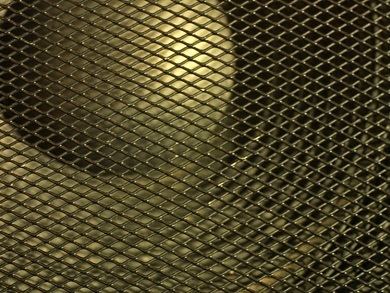
In copper hydride, elements adopt the Wurtzite crystal structure (polymeric), being connected by covalent bonds. Other lower metal hydrides polymerise in a similar fashion (c.f. aluminium hydride). Under certain conditions, a metastable amorphous solid forms. This solid decomposes above 60 °C (140 °F).
Chemical reactions
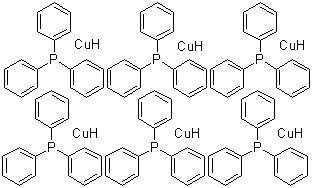
CuH generally behaves as a source of H–. For instance, Wurtz reported the double displacement reaction of CuH with hydrochloric acid:
CuH + HCl (aq) → CuCl +H2
When heated above −5 °C (23 °F), copper hydride decomposes to produce a copper hydride alloy and hydrogen gas:
CuH → Cu + x H + ½(1 − x) H2
Solid copper hydride is the irreversible autopolymerisation product of the molecular form, and the molecular form cannot be isolated in concentration.
Production
Copper does not react with hydrogen even on heating, thus copper hydrides are made indirectly from copper(I) and copper(II) precursors. Examples include the reduction of copper(II) sulfate with sodium hypophosphite in the presence of sulfuric acid, or more simply with just hypophosphorous acid. Other reducing agents, including classical aluminium hydrides can be used.
4 Cu2+ + 6 H3PO2 + 6 H2O → 4 CuH + 6 H3PO3 + 8 H+The reactions produce a red-colored precipitate of CuH, which is generally impure and slowly decomposes to liberate hydrogen, even at 0 °C.
2 CuH → 2 Cu + H2This slow decomposition also takes place underwater, however there are reports of the material becoming pyrophoric if dried.
Reductive sonication
Copper hydride is also produced by reductive sonication. In this process, hexaaquacopper(II) and hydrogen(•) react to produce copper hydride and oxonium according to the equation:
[Cu(H2O)6]2+ + 3 H• → 1/n (CuH)n + 2 [H3O]+ + 4 H2OHydrogen(•) is obtained in situ from the homolytic sonication of water. Reductive sonication produces molecular copper hydride as an intermediate.
Molecular form
Molecular copper hydride (systematically named hydridocopper) is a related inorganic compound with the chemical formula CuH. It is a metastable, colourless gas. It is classified as a strong reductant.
History
Molecular copper hydride was discovered in the vibration-rotation emission of a hollow-cathode lamp in 2000 by Bernath, who detected it at the University of Waterloo. It was first detected as a contaminant while attempting to generate NeH+ using the hollow-cathode lamp. Molecular copper hydride has the distinction of being the first metal hydride to be detected in this way. (1,0) (2,0) and (2,1) vibrational bands were observed along with line splitting due to the presence of two copper isotopes, 63Cu and 65Cu.
The A1Σ+-X1Σ+ absorption lines from CuH have been claimed to have been observed in sunspots and in the star 19 Piscium.
Chemical properties
Molecular copper hydride has acidic behavior for the same reason as normal copper hydride. However, it does not form stable aqueous solutions, due in part to its autopolymerisation, and its tendency to be oxidised by water. Copper hydride reversibly precipitates from pyridine solution, as an amorphous solid. However, repeated dissolution affords the regular crystalline form, which is insoluble. Under standard conditions, molecular copper hydride autopolymerises to form the crystalline form, including under aqueous conditions, hence the aqueous production method devised by Wurtz.
Production
Molecular copper hydride can be formed by reducing copper iodide with lithium aluminium hydride in ether and pyridine. CuI + LiAlH4 → CuH + LiI + AlI3 This was discovered by E Wiberg and W Henle in 1952. The solution of this CuH in the pyridine is typically dark red to dark orange. A precipitate is formed if ether is added to this solution. This will redissolve in pyridine. Impurities of the reaction products remain in the product. In this study, it was found that the solidified diatomic substance is distinct from the Wurtzite structure. The Wurtzite substance was insoluble and was decomposed by lithium iodide, but not the solidified diatomic species. Moreover, while the Wurtzite substance's decomposition is strongly base catalysed, whereas the solidified diatomic species is not strongly affected at all. Dilts distinguishes between the two copper hydrides as the 'insoluble-' and 'soluble copper hydrides'. The soluble hydride is susceptible to pyrolysis under vacuum and proceeds to completion under 100 °C.
Anhydrous reduction
Amorphous copper hydride is also produced by anhydrous reduction. In this process copper(I) and tetrahydroaluminate react to produce molecular copper hydride and triiodoaluminium adducts. The molecular copper hydride is precipitated into amorphous copper hydride with the addition of diethyl ether. Amorphous copper hydride is converted into the Wurtz phase by annealing, accompanied by some decomposition.
Direct synthesis
It can be directly synthesised when copper and hydrogen is exposed to 310 nanometre radiation.
Cu + H2 ↔ CuH + H•This route is difficult to control, since there is little or no activation barrier for the reverse reaction, which occurs readily even at 20 Kelvin.
Applications in Organic Synthesis
Polymeric [CuH]n exhibits poor solubility and stability and is rarely used in organic synthesis. However ligated copper hydride species, LnCuH (L = PR3 or NHC), which may be oligomeric or monomeric in solution, are commonly employed in organic synthesis. Whitesides first described the reducing properties of phosphine-ligated copper hydride species. Stryker popularized the hexameric [(Ph3P)CuH]6 (Stryker's reagent) as a mild and selective reagent for the conjugate reduction of α,β-unsaturated carbonyl compounds.
Shortly thereafter, Stryker reported the use of H2 (at least 80 psi) as the terminal reductant, allowing a catalytic amount of [(Ph3P)CuH]6 to be used for conjugate reduction reactions. Subsequently, Hiyama reported that hydrosilanes (H-SiR3) could be used as a convenient alternative to H2 for the regeneration of a LnCuH species.
Although no mechanistic rationale was offered at the time, Brunner was the first to report that hydrosilylation of acetophenone in the presence of a chiral phosphine-copper catalyst afforded enantioenriched product (up to 40% ee). This process is now recognized to proceed through the enantioselective addition of L*CuH across the C=O bond. Buchwald developed a highly enantioselective (80 to 92% ee) reduction of prochiral α,β-unsaturated esters using Tol-BINAP as a chiral ligand for copper in the presence of PMHS as the reductant. Lipshutz subsequently developed conditions for the CuH-catalyzed hydrosilylation of ketones and imines proceeding with excellent levels of chemo- and enantioselectivity.
The reactivity of LnCuH species with weakly activated (e.g. styrenes, dienes) and unactivated alkenes (e.g. α-olefins) and alkynes has only recently been recognized and has served as the basis for several copper-catalyzed formal hydrofunctionalization reactions.
Other copper hydrides
2) also exists, in the form of an unstable reactive intermediate in the reduction of copper hydride by atomic hydrogen.
